Deep red light at 670 nanometers wavelength can substantially boost your eye health, improving color contrast vision by up to 20%. You'll get the best results with just three minutes of exposure in the morning, which helps your retinal cells produce more energy. While you want to maximize beneficial red light, you should minimize exposure to blue light (400-500 nanometers), especially from digital devices. Blue light can strain your eyes and potentially damage your retina over time. To protect your vision, consider using blue light filters and specialized computer glasses. There's much more to discover about optimizing your eye health through light wavelengths.
Understanding Light and Vision Basics

Light waves dance across the electromagnetic spectrum, but your eyes detect only a small portion ranging from 380 to 780 nanometers. Within this narrow band, you'll find all the colors that make up your visual world, from deep reds to vibrant violets.
Each wavelength carries different energy levels, with shorter wavelengths packing more punch than longer ones. Modern LED light sources contain higher proportions of blue wavelengths compared to traditional lighting.
You're most sensitive to blue light, which falls between 400 to 500 nanometers. While this sensitivity helps you see clearly during daylight hours, it can also pose challenges. Blue light's higher energy levels mean it's more likely to cause eye strain and potential retinal damage, especially during prolonged exposure to digital screens.
Think of light's components like a rainbow: red, orange, yellow, green, blue, indigo, and violet. Each color plays a unique role in how you perceive the world.
However, wavelengths outside your visible range, such as ultraviolet and infrared, can still affect your eyes even though you can't see them. They may cause heating effects or biological damage, which is why protecting your eyes from these invisible wavelengths is essential for maintaining healthy vision.
The Power of Deep Red
Your eyes can gain remarkable benefits from deep red light therapy, particularly when you're exposed to 670nm wavelengths in the morning hours.
The morning exposure triggers your retinal mitochondria to boost energy production, leading to an average 17% improvement in color contrast vision that lasts for at least a week.
You'll get the most from this therapy by sticking to morning sessions, as afternoon exposure hasn't shown the same vision-enhancing effects. The treatment is especially effective for older adults, with some showing 20% vision improvement after exposure.
Morning Exposure Benefits
Recent scientific breakthroughs have revealed that just three minutes of deep red light exposure in the morning can substantially enhance declining eyesight. Research shows that a single morning session can improve color contrast vision by 17%, with benefits lasting at least a week. The LED devices used in these treatments are remarkably affordable, costing only about £12 to manufacture.
What's particularly fascinating is that afternoon exposure doesn't yield the same results, making timing essential for this therapy.
You'll find this treatment especially beneficial if you're over 40, as your retina ages faster than other organs due to its high energy demands. The 670nm deep red light gets absorbed by your retinal mitochondria, boosting energy production where it's needed most.
Key benefits you'll experience from morning red light exposure include:
- Significant improvement in color contrast vision
- Long-lasting effects from just one weekly session
- Simple, affordable home-based therapy option
- Natural support for age-related vision decline
This groundbreaking discovery opens up possibilities for accessible eye health maintenance. The therapy's simplicity and effectiveness make it a promising solution for millions experiencing natural vision decline, potentially transforming how we approach eye care in aging populations.
Mitochondrial Energy Production
The remarkable benefits of morning red light therapy stem from its profound effects on mitochondrial energy production. When your retinal cells are exposed to deep red light wavelengths between 650-900nm, they trigger increased ATP production in your mitochondria.
This boost in cellular energy is particularly essential for your retina's photoreceptor cells, which contain the highest density of mitochondria and require substantial energy to function properly. Research shows that three-minute morning sessions can improve vision for up to a week, making it a highly efficient treatment option.
Your mitochondria respond differently to various wavelengths of light. While blue light can reduce ATP production, deep red light enhances it, helping restore youthful levels of energy production in your retinal cells.
This increased energy output directly supports your photoreceptors' ability to process visual information, leading to improved color contrast sensitivity and better overall vision. The enhancement in mitochondrial performance through deep red light exposure specifically targets the natural decline in cellular energy production that occurs with aging.
Blue Light Dangers Explained
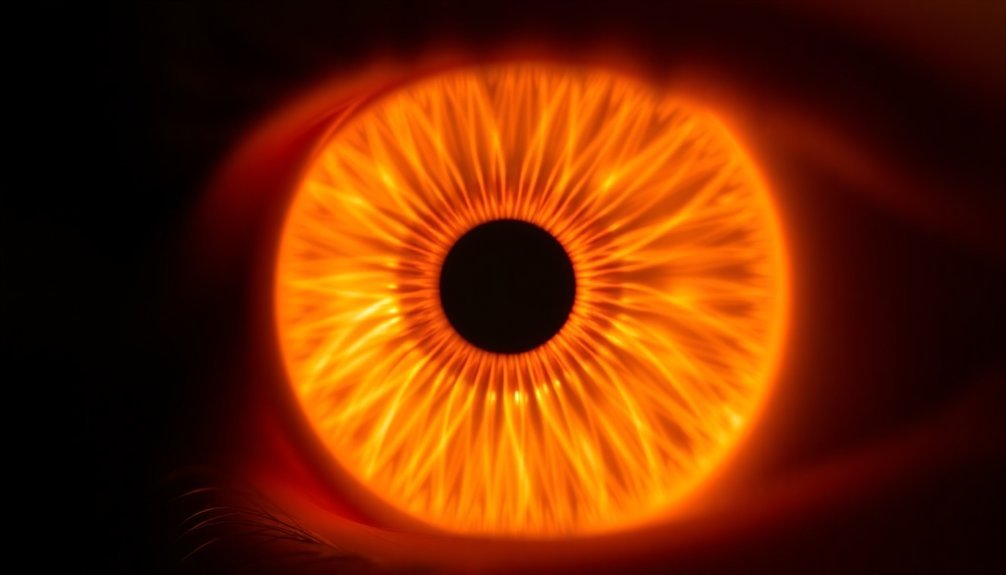
Modern digital devices emit potentially harmful blue light wavelengths between 415 and 455 nanometers, posing various risks to eye health. Your daily exposure to blue light comes from multiple sources, including smartphones, tablets, LED lights, and the sun. While natural blue light exposure isn't inherently dangerous, the prolonged, close-range exposure from digital devices can lead to significant health issues.
Your eyes are particularly vulnerable to blue light damage because these wavelengths pass directly to your retina. This exposure can trigger various eye health concerns, especially when you're using digital devices for extended periods.
Children face even greater risks since their eyes don't filter blue light as effectively as adult eyes.
Key impacts of blue light exposure include:
- Digital eyestrain, affecting about 50% of computer users with symptoms like dry eyes and blurred vision
- Disrupted sleep patterns due to suppressed melatonin production, particularly from nighttime device use
- Potential long-term retinal damage that may contribute to age-related macular degeneration
- Increased risk of cataracts and permanent vision changes with continued exposure
To protect your eyes, consider using blue light filters and limiting screen time, especially before bedtime.
Protective Measures for Eye Health
Protecting your eyes through proper safety equipment has become essential in today's diverse work and recreational environments. Different situations require specific types of protection to effectively shield your eyes from various hazards.
For mechanical work environments, you'll need safety glasses with shatter-resistant lenses and side shields to protect against flying debris. If you wear prescription lenses, you can get safety glasses customized to your needs.
When working with chemicals or vapors, you'll want non-vented goggles that completely seal around your eyes. For less hazardous liquid exposure, vented goggles with baffle plates offer protection while allowing airflow.
Face shields provide an additional layer of protection but shouldn't be used alone – you'll need to wear appropriate goggles underneath.
For outdoor activities, make sure your sunglasses meet UV400 standards, blocking 100% of UVA and UVB rays. You'll get better protection from wraparound styles that prevent UV rays from entering from the sides. While polarized lenses help with glare, they don't affect UV protection.
For maximum outdoor protection, combine UV-blocking sunglasses with a broad-brimmed hat.
Morning Light Benefits

Your timing matters when it comes to protecting your eyes, as research shows that just three minutes of deep red light exposure in the morning can substantially improve declining vision.
You'll get the most benefits from deep red light at 670 nanometers wavelength, which effectively recharges the energy systems in your retinal cells when used once a week.
Starting these protective measures early can help maintain your eye health, especially since morning exposure proves more effective than afternoon treatments for enhancing color contrast sensitivity.
Timing Is Everything
Recent research has revealed that timing plays a critical role in how our eyes respond to light therapy, particularly when it comes to deep red light exposure. If you're looking to improve your declining vision through light therapy, you'll want to focus on morning treatments between 8 am and 9 am.
Studies show that your retinal mitochondria are more responsive during these early hours, while afternoon exposure yields no measurable improvements.
The study's findings demonstrate that just three minutes of exposure to 670 nanometer deep red light in the morning can enhance your color contrast vision by 17%, with benefits lasting at least a week. Your body's circadian rhythm plays an essential role in this process, making morning light exposure particularly effective for vision enhancement.
Key benefits of morning light exposure:
- Improves declining eyesight and color contrast vision
- Recharges retinal cell energy systems effectively
- Requires only one three-minute session per week
- Aligns with your body's natural circadian rhythm
This timing-specific approach could revolutionize home-based eye therapies, offering an affordable and accessible solution for maintaining eye health as you age.
Deep Red Benefits
Building on the importance of morning timing, deep red light at 670 nanometers offers remarkable benefits for aging eyes. When you expose your eyes to just three minutes of this specific wavelength in the morning, you'll experience a 17% improvement in color contrast vision, with effects lasting at least a week.
| Benefit | Mechanism | Impact |
|---|---|---|
| Vision Enhancement | Boosts mitochondrial energy | 17% better color contrast |
| Longevity | Improves ATP production | Week-long effects |
| Accessibility | Simple LED device usage | Home-based therapy |
| Aging Support | Targets retinal cells | Reduces vision decline |
Your retina ages faster than other organs, experiencing a 70% reduction in ATP over your lifetime. Deep red light therapy directly addresses this issue by enhancing your mitochondrial function, particularly in photoreceptor cells that require high energy levels. The light penetrates your retinal cells, stimulating energy production where it's needed most.
You'll find the most success using LED devices rather than lasers, as they're safer and more suitable for home use. The key is maintaining the specific 670nm wavelength at proper intensity levels (8mW/cm2) during your morning exposure for ideal results.
Protect Your Vision Early
Natural morning light serves as a powerful tool for protecting and enhancing vision health. When you expose your eyes to morning sunlight, you're activating essential biological processes that support both your vision and overall well-being.
The rich red and infrared wavelengths present in morning light energize your cells while promoting healthy eye function and circadian rhythm regulation.
To maximize the benefits of morning light exposure for your vision, you'll want to:
- Get at least five minutes of direct morning sunlight daily to trigger serotonin and dopamine production
- Maintain consistency in your morning light exposure routine to properly regulate your circadian rhythm
- Take advantage of the UVA light present in morning sun, which supports both eye health and vision maintenance
- Time your exposure early in the day to prevent evening blue light from disrupting your melatonin production
This morning light exposure isn't just about immediate benefits – it's an investment in your long-term eye health. By incorporating regular morning light exposure into your daily routine, you're supporting your body's natural rhythms while protecting and strengthening your vision through beneficial wavelengths.
Age-Related Vision Support Solutions
As we age, our eyes undergo natural changes that can substantially impact daily activities like reading, driving, and using digital devices. You'll likely notice changes in near vision around age 40, along with increased difficulty seeing in dim light and distinguishing between similar colors.
The good news is that cutting-edge solutions are emerging alongside traditional treatments. While corrective eyewear and proper lighting remain essential, breakthrough research in red light therapy shows promising results. Just three minutes of exposure to 670nm deep red light in the morning can improve your color contrast vision by 17%.
| Vision Challenge | Solution Strategy |
|---|---|
| Near Vision Loss | Corrective lenses & red light therapy |
| Dim Light Problems | Enhanced lighting & pupil exercises |
| Color Contrast Issues | Deep red light exposure (670nm) |
| Night Driving | Anti-glare lenses & contrast enhancement |
You can take proactive steps by combining traditional and emerging therapies. Use proper lighting and vision aids for immediate relief, while incorporating weekly red light therapy sessions. Remember to maintain regular eye exams and protect your eyes from UV and blue light exposure to maximize these benefits.
Digital Eye Strain Prevention
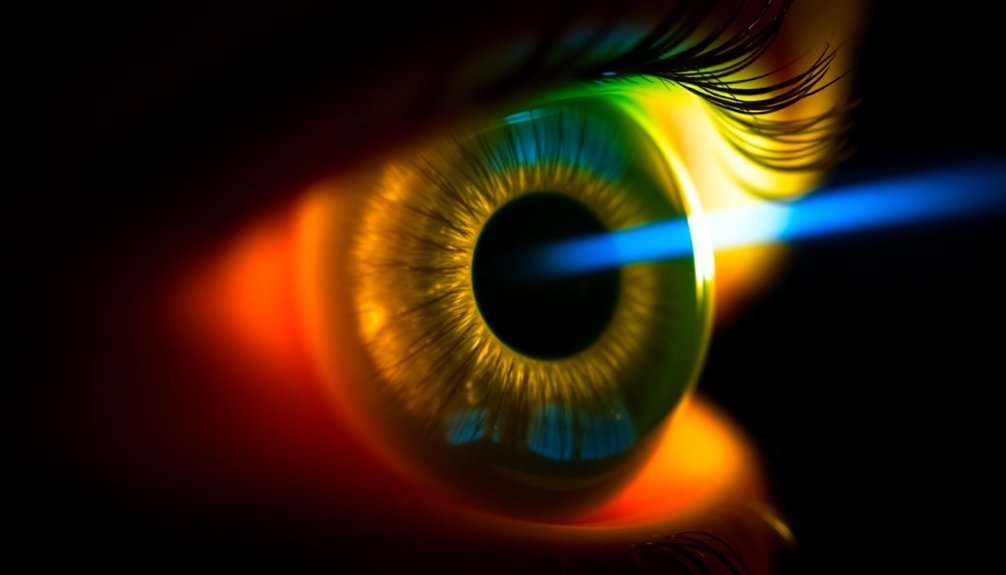
The rise of digital devices brings new challenges to aging eyes, particularly in the form of digital eye strain. When you spend long hours staring at screens, you'll likely experience symptoms like eye dryness, blurred vision, and headaches.
While blue light from screens won't damage your eyes directly, prolonged screen exposure can cause significant discomfort and affect your sleep patterns.
To protect your eyes during screen time, implement these proven prevention strategies:
- Follow the 20-20-20 rule religiously: every 20 minutes, look at something 20 feet away for 20 seconds to reduce eye fatigue
- Position your screen slightly below eye level and maintain a distance of at least 20-24 inches to encourage natural blinking
- Adjust your display settings for comfort, focusing on brightness, contrast, and text size that don't strain your eyes
- Use artificial tears and maintain proper workspace humidity by avoiding direct air conditioning or heating vents
Remember to maintain an ergonomic workspace with appropriate lighting and consider using screen filters or computer glasses with anti-reflective coatings.
Regular eye exams remain essential for monitoring your eye health as you adapt to increased screen time.
Frequently Asked Questions
Can Specific Wavelengths of Light Help With Night Vision Capabilities?
Yes, red light wavelengths (630-670 nm) will enhance your night vision abilities while preserving your visual acuity in low-light conditions. You'll want to avoid blue light, which disrupts night vision capabilities.
How Do Different Colored Contact Lenses Affect Beneficial and Harmful Wavelengths?
You'll find colored contacts affect light differently: SW filtering lenses block harmful blue-violet light (380-450nm), while photochromic lenses enhance contrast by cutting specific wavelengths. Avoid non-prescription lenses for eye safety.
Do Artificial Red Light Therapy Devices Provide the Same Benefits as Natural Light?
No, while red light therapy offers specific eye health benefits like reduced inflammation and ATP production, you'll still need natural sunlight for essential functions like vitamin D production and proper biorhythm regulation.
Can Certain Wavelengths Enhance Peripheral Vision and Motion Detection?
Yes, specific wavelengths can boost your peripheral vision and motion detection. You'll get the best results from deep red light (670nm) and syntonic phototherapy, which uses targeted light frequencies to improve your visual performance.
Does Eye Color Influence Sensitivity to Different Light Wavelengths?
Yes, your eye color affects light sensitivity. If you've got lighter eyes, you'll be more sensitive to light across wavelengths due to less melanin, while darker eyes provide better natural protection against light.
In Summary
You'll find that managing your exposure to different light wavelengths plays a vital role in maintaining healthy vision. Focus on getting adequate deep red light exposure while protecting yourself from excessive blue light. Start your day with natural morning sunlight, use protective measures when facing digital screens, and consider age-appropriate vision support. By understanding how different wavelengths affect your eyes, you can better protect your long-term eye health.
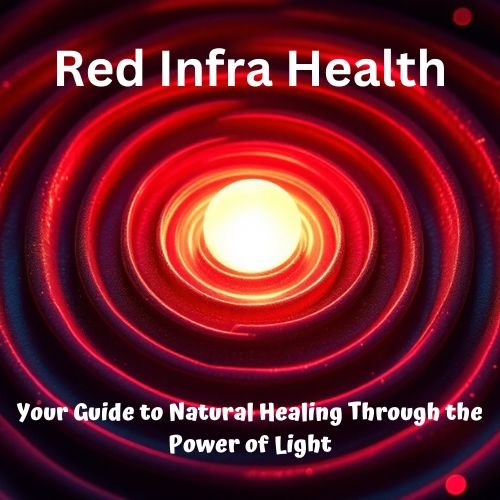
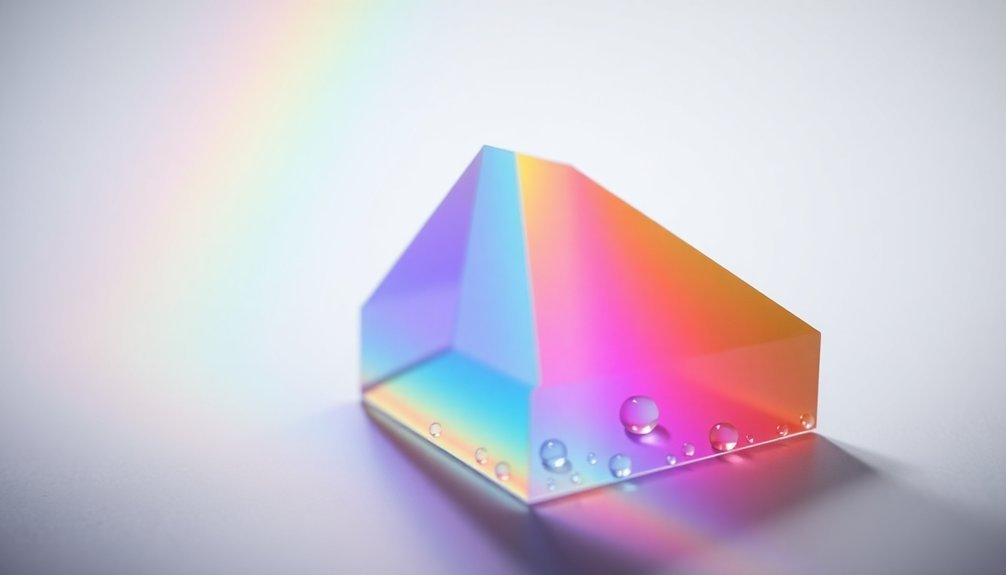

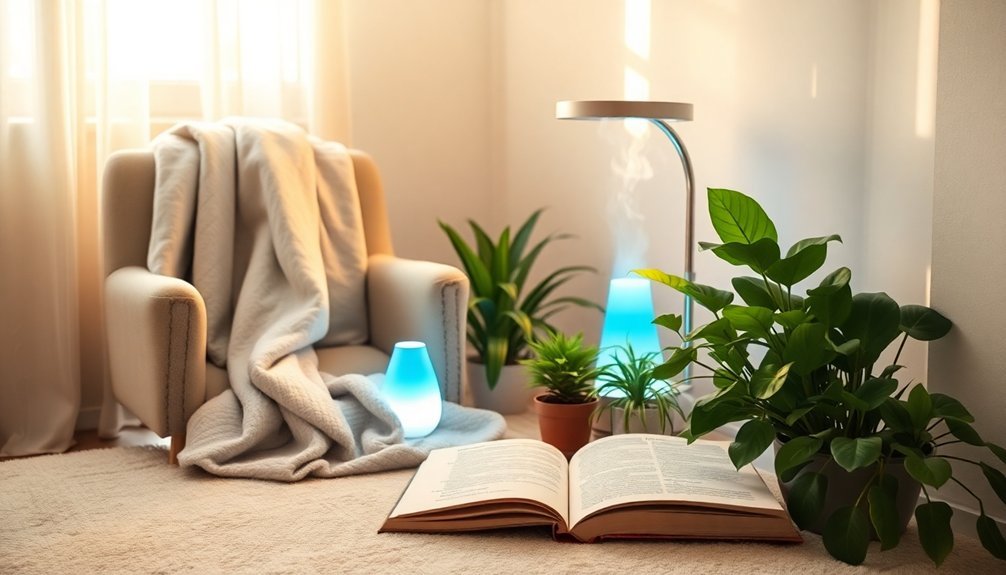

Leave a Reply